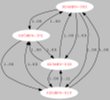|
How to test Port Forwarding |
 |
 |
 |
|
Written by David Rivenburg, AD5OO
|
|
Tuesday, 02 March 2010 19:24 |
|
In some ways, HSMM-MESH™ is a very unique network. In other ways, it acts just like a conventional network - which is why conventional networking skills are a benefit when using the mesh. Making private LAN servers publicly available to the internet through the WAN side of a standard NAT router is one of these skills. Making a server available to the mesh is essentially the same process except that it uses WiFi interface of a mesh node instead of the usual WAN interface.
If you have a computer that you want other mesh users to be able to connect with, then you are putting a server on the mesh. If you are not yet comfortable with the way the mesh works, you can use standard routers to test your setup and see if what you are trying to do will actually work. If you don't have any standard routers left after converting them to mesh nodes, you can re-install the factory Linksys firmware on the node Administration page by refreshing the Download Firmware list and clicking Download.
The following method can test the setup that you plan to use with a NAT enabled mesh node. It requires two standard routers and a cable to connect the WAN ports of those routers to each other. Depending on the specific router you are using you may need a crossover cable for this to work. The WRT54G does not need a crossover cable. You can also use a separate ethernet switch to connect each WAN port. The presence of a link light on the WAN jacks or the front panel means that it is working.
The routers will be called router1 and router2. Put your server(s) on the LAN of router1, and the clients on the LAN of router2. The task is to get the router2 clients talking to the servers on router1.
You now need to set up the WAN ports of both routers with static IP addresses. Log in to the administration interface of each router. Set the WAN address of router1 to 10.0.0.1 with a netmask of 255.255.255.0. Set the WAN address of router2 to 10.0.0.2 with the same netmask. Default routes/gateways and DNS servers will not be required. If the administration interface forces you to enter them, use 10.0.0.2 on router1 and 10.0.0.1 on router2.
If all is well, you should be able to ping both 10.0.0.1 and 10.0.0.2 from the computers connected to both routers. If not, you have to fix that before proceeding. Sometimes there is a checkbox for whether to allow pings on the WAN interface. If in doubt, you can also disable the firewall. Also, if you have a choice between gateway or router mode, be sure to choose gateway so that NAT will be in effect.
At this point your test network is ready. Now you must set up the port forwarding rules on router1 so that the clients behind router2 can access the server on router1. The server and client applications are up to you. Tell the clients to use 10.0.0.1 as the remote server.
My only suggestion when setting up the port forwarding rules is that you do not use any predefined services that may be listed. Use a custom service and enter the port numbers explicitly, otherwise the router may be taking special considerations for that service into account, which a mesh node will probably not do. You will have to know the port numbers anyway, and this is this time to use them.
If you get stuck here, or if this description does not make sense, you have some education ahead of you. Port forwarding, LANs, WANs, and routing are topics that are covered in excruciating detail on the web and in bookstores. This is a standard networking practice. If you cannot get your setup working in this configuration, you will not get it working on the mesh either. The only difference is that this test network conforms with the abundant documentation from numerous sources, whereas the mesh documentation assumes you already have these skills.
If you get it working, congratulations. The same set of port forwarding rules should transfer identically to a mesh node - just apply them to the WiFi interface instead of the WAN interface. With the standard routers you may not have had the ability to change the port numbers between the outside (WAN/WiFi) ports and inside (LAN) ports. You can do this on a mesh node, so you can run multiple servers on the same inside ports by using different outside ports.
Good luck and 73
ad5oo
|
|
Last Updated on Wednesday, 03 March 2010 01:32 |



